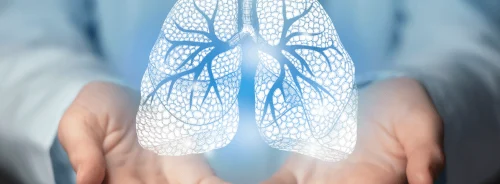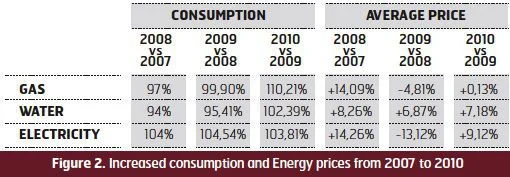HealthManagement, Volume 14, Issue 3 /2012
The University Hospital Authority St. Orsola-Malpighi Polyclinic of Bologna is organised into seven departments of integrated activities (DAI), including 91 operational units and is equipped with 1,758 beds with a staff of 5,355 employees. 72,000 hospitalisations are carried out per year and 4,000,000 specialist services are made for outsiders. Overall an estimated 20,000 people visit the hospital daily (employees, students and academics, patients, visitors and contractors, etc.). Since 2007 the project has focused on reducing energy consumption and increasing environmental sustainability.
The project is based on strategic health estate planning to achieve results in the short, medium and long term. This is achieved by new technologies based on low carbon solutions for energy efficiency in the maintenance and transformation of business assets (facilities, plants, technologies and equipment) and raising awareness of internal staff and healthcare services users (internal and external infrastructural staff, users, visitors, students, etc.). The purpose is to pursue a greater sharing of common aims and to contribute to the progressive improvement of environmental conditions in which we work and live.
Design Strategy
It is important to differentiate between a next generation hospital designed from the beginning to achieve low power consumption and an existing hospital featuring pavilion blocks built in different historical periods with high-energy consumption. In this case is very important to intervene in all levels through a strategy for short, medium and long term with attention on the one hand to daily actions and to behaviours of all people and on the other to the use of new technologies and of renewable energy in order to improve efficiency in maintenance and transformation of hospital real estate (structures, plants, technologies and equipment) and through participatory decision paths and forms of comparison between different services.
The strategy for rational use and energy saving is based on different but converging intervention lines so their synergies can be properly exploited. It includes:
• Actions on energy efficiency of heating systems and lighting systems;
• Use of energy renewable sources, water saving and waste reduction;
• Application of green procurement principles;
• Management of yards (across the entire process from materials procurement to waste); and
• Providing training and information to all operators.
The hospital established a new group entitled 'Environmental Management and Sustainable Development' to define corporate strategies for information, education and training of workers and to define roles of the new posts of Mobility Manager and Energy Manager; figures of great importance in environmental management processes. The group is also in charge of checking the effectiveness of new technological solutions, the qualitative and quantitative results in terms of energy consumption, the waste management products and of the operating costs incurred over the years for each type of intervention. The main purpose was to create a culture for a winning sustainability that pursues the ethical and moral commitment of contributing to the environmental protection through greater awareness and the involvement of staff and all users dealing with contracts, jobs, facilities and services.
Projects and Interventions
The strategies taken at the technological innovation level involved the implementation of significant projects carried out from 2007 to 2010. The planned measures were oriented around the rational use of heating energy, electricity and water. The design choices were determined primarily by the costs and payback through stakeholder involvement in the planning, management and maintenance of works to be done.
For heating energy, a system for monitoring and automated management of heating systems has been adopted. This optimises the internal temperature compensation curves based on outdoor temperature, reduces the extra hours of heated operating rooms during holidays, at night and in absence of activity. Fixtures have been replaced in order to install a type of thermal break, floors are insulated to reduce energy losses and thermostatic valves on radiators regulate room temperature. The implementation of these interventions has allowed an average saving of 551,636 mc per year for heat consumption with a saving of over 300,000 euro per year. Systems based on controlled mechanical ventilation with heat recovery activities were installed into the construction of the new Surgical and Emergency Complex; that allows an overall reduction between winter and summer period of about 160 tons of CO2.
The most innovative work regards the construction of a co-trigeneration plant for more than 6 MW that will deliver energy savings equal to 29% of all the hospital's total consumption with an annual saving of more than 8,000 tons of equivalent CO2 and cost savings from 3,800,000 to 4,600,000 euro per year. It was possible thanks to the available resources of project-financing.
Regarding electricity, the interventions adopted include: The replacement of incandescent/ fluorescent lighting systems with fluorescent, A2 efficient, longer life and low power consumption ones; the gradual replacement of electric motors over 5 KW with high F1 class efficiency motors in case of breakage or extraordinary maintenance; the installation of LED lighting systems; the installation of freecooling plants in some conditioned rooms such as technical rooms that house the UPS and batteries.
The rate of electricity consumption was in line with regional average increases of 4-5% per year. This rate is due to the continuous increase of equipment (electromedical, refrigeration units, computers, etc…) and of air conditioning systems in more areas. A further increase in electricity consumption occurs with the set up of the new Surgical and Emergency Complex, the new building which houses 12 new operating rooms and an emergency area.
Water consumption peaks during the summer months due to increased use of air conditioning so centralised installation cooling towers were installed. Seven softening systems for the cooling towers allow the break down of suspension salts and therefore reduce high quantities of water drainage and replenishment. The consolidated annual water savings is 100,000-120,000 m3 per year of water and cost savings at current prices of about 310,000-370,000 euro per year. Another significant intervention was the progressive elimination of all water loss cooling systems such as the elimination of refrigerator- cooled water loss cells of the kitchen or the replacement of liquid ring heating pumps with those cooling air.
Controlled Mechanical Ventilation with Active Heat Recovery
A new innovative system of waste heat recovery for air renewal was installed. The system allows the recovery of waste heat through the use of heat pumps associated with hydronic circuit connected to the extractors and to the air-handling unit; this allows a yield of 60% instead of 30% from conventional solutions of heat recovery using simple hydronic circuit for heat exchange.
The use of a heat water pump powered by electricity provides a decrease of outlet air temperature and transfers the heat to the batteries of pretreatment air unit through the use of the hydronic circuit. In this way an adequate temperature difference between the water of the hydronic circuit and the inlet air is always guaranteed, while maintaining high the efficiency of the system.
The active recovery system of heat places the building in the energy class of type D with a primary energy demand in winter amounted to 42,45 KWh/m3, while the use of conventional recovery would place the building in the energy class of type F with a primary energy demand amounted to 67,32 kWh/m3. As regards the saving of CO2 emitted into the atmosphere, the active recovery system of heat allows a reduction of approximately 160 tonnes of CO2 between winter and summer. The reduction of emission will be particularly reduced by more than 8% in winter and about 24% in summer.
Co-Trigeneration Plant
This is the most important aspect of the project. This plant with more than 6MW will deliver a saving about 6,000 TOE (tonnes of oil equivalent) per year, 29% of which is polyclinic energy consumption, a saving of more than 8,000 tonnes of equivalent CO2 and cost savings from 3,800.000 to 4,600,000 euros per year. This economic saving will allow to finance most of the following new projects:
• St.Orsola-Malpighi thermal power plant;
• Malpighi steam power plant;
• Therm-refrigeration power plant;
• Distribution systems (hot water, steam, chilled water);
• Substations systems;
• Drinking water network;
• Networking and industrial water wells;
• Fire works and exits through the tunnels; and
• Palagi pavilion block refrigeration plant.
Results
From a management perspective the implemented systems allow continuous documentation and verification by all operators who are called to contribute to the achievement of results.
The originality of the project lies primarily in two aspects: The involvement of all operators through their daily behaviour in the use of available resources and the use of project financing for the procurement of the necessary economic resources for implementing the interventions on plants.
Conclusions
All actions taken were focused on oriented design solutions, constructive projects, organisation and management and aligned with guidelines of the Kyoto Protocol and Johannesburg Declaration. It is always possible to verify and document the results obtained, even in economic terms of cost saving.
The overall impression is positive. The project successfully spreads the culture of low carbon solutions for energy efficiency and environmental sustainability through the involvement of both users and professionals. The approach we intend to pursue is therefore to diffuse, constantly day after day, the culture for a winning sustainability for all, both at work and at home.
 Figure 1. Photomap of the University Hospital Authority St.Orsola-Malpighi Polyclinic area
Figure 1. Photomap of the University Hospital Authority St.Orsola-Malpighi Polyclinic area







